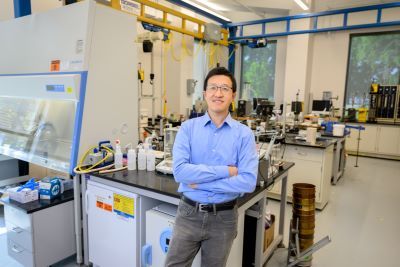Where some people see an eyesore that needs to be destroyed, LSU Civil and Environmental Engineering Professor Hai “Thomas” Lin sees inspiration for the future.
Lin’s latest research project, funded by a nearly $630,000 National Science Foundation CAREER Award, is taking characteristics from mud dauber nests and the root systems of fungi to design 3D-printed soil for sustainable, durable, and cost-effective earthen buildings. More than three billion people around the world live in earthen buildings, which are gaining popularity in Europe, Western Australia, Canada, and California because of their eco-friendly and cost-effective credentials.
“Mud daubers are expert soil nest builders,” Lin said. “Mud daubers carefully select the best type of soil for their nests, manage the moisture content of the soil to make it easier to work with, tap the soil repeatedly with their front legs and jaws to compact and make it stronger, and use the natural drying power of the air to harden the soil. Their nest shape is in clusters of tube-like cells, which make the nests light but strong, stable, and insulated.
“These techniques can inspire modern earthen building construction using 3D soil printing. By applying similar principles—controlling soil and moisture content, compacting the soil with vibrations, utilizing natural drying processes, and designing cellular structures—we can significantly enhance the strength, stability, and efficiency of earthen buildings.”
So, how does 3D soil printing work?
The process begins by mixing soil with fungal spores and natural fibers, creating a soil-fungal mixture for optimal plasticity; printing and compacting the soil simultaneously; and allowing the fungal root structure to grow, reinforce, and waterproof the structure. Finally, the mixture dries, which further enhances the strength of the earthen walls.
“To increase efficiency, the method incorporates modular construction,” Lin said. “This means that tubular elements, inspired by mud dauber nests, are printed in a controlled environment and then assembled on-site to build the final structure. This approach not only enhances the durability and sustainability of earthen buildings but also speeds up construction and reduces waste. By combining nature’s wisdom with cutting-edge technology, this method offers a smart, eco-friendly way to construct the homes of the future.”
Lin acknowledges that the idea of living in an earthen building might evoke mental images of primitive or uncomfortable structures, but he’s quick to add that the type of structures he’s proposing are anything but.
“Earthen buildings today can be as sophisticated and stylish as any contemporary structure, with the added advantage of natural insulation, excellent indoor air quality, remarkably small embodied energy, and a significantly reduced environmental impact,” Lin said. “Far from living in a ‘mud dauber’s nest,’ you’d be living in a modern, eco-friendly home that’s designed with sustainability, comfort, and durability in mind. Essentially a home that’s built for the future, not the past.”
While the outcomes of this project could have a major impact on the future of housing and home building, the funding source behind it—the NSF CAREER Award—is sure to have a similar impact on the future of Lin’s academic career and is a reflection of his past work and achievements.
“I’m extremely happy and grateful to receives this NSF CAREER Award,” Lin said. “This recognition marks a significant milestone in my career and provides a solid foundation for the next 5-10 years of my research and teaching endeavors. With this support, my research team and I can continue pursuing my long-term goal of advancing sustainable, durable, and cost-effective earthen buildings through innovative bio-mediated and bio-inspired processes. This award not only validates our efforts but also energizes us to push the boundaries of what’s possible in sustainable construction.”
Like us on Facebook (@lsuengineering) or follow us on X (formerly Twitter) and Instagram (@lsuengineering).
Feature Image Courtesy of: LSU College of Engineering









 The 2024 virtual Men’s Round Table will be held Q4, 2024, date TBD.
The 2024 virtual Men’s Round Table will be held Q4, 2024, date TBD.













